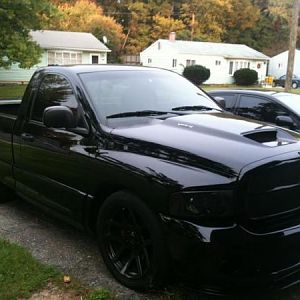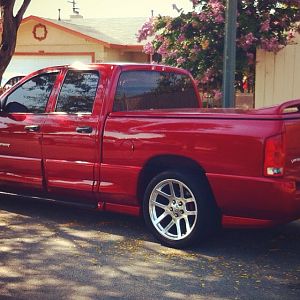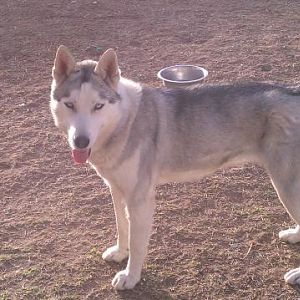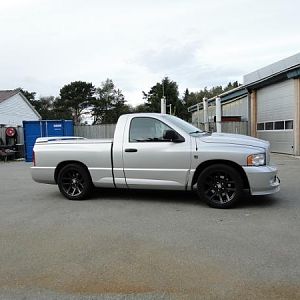You are using an out of date browser. It may not display this or other websites correctly.
You should upgrade or use an alternative browser.
You should upgrade or use an alternative browser.
What weight oil
- Thread starter chargerman426
- Start date
My understanding that if you have 0W40 and say 15W40 that when the oil is hot say 180F that the viscosity of the oil is the same. Isn't this true??
Yes Joe, it is true.
ZERO is the base weight (in the case of 0-40; or 15 is the base if it is a 15-40, etc.).
Viscosity Index Improvers are added to it until it becomes a 40 weight (in these examples).
And now you will have no more sleepless nights wondering what the truth is.
Ron
Last edited:
Falcon
Full Access Member
So what would you suggest for Arizona use? In the winter we get down to about 50-60 degrees (we get colder but that is only during times of the night that my truck will not be operating) and in the summer we average over 100 degrees. Should I bother switching back and forth? Or would I be good just sticking with the same oil weight since we don't experience very cold temps?
rare03srt10
Full Access Member
i used 0/40 once and then started using 15/40 here in Cali and the only difference i noticed was the PRICE lol. Much cheaper for 15/40 and the truck feels and sounds the exact same.
I use Eneos 5-40 synthetic. Expensive , but I did a search on the best high performance oil and this one made the most horsepower all things being equal. I've been using it for over 5 years, change every 3,000 miles and no issues or oil usage. I have an 04 RC with 59,500 miles and probably more trips down the 1/4 mile than anyone here on the website.
0-40 winter 15-50 summer
What the old fart said, :elefant:
Yes Joe, it is true.
ZERO is the base weight (in the case of 0-40; or 15 is the base if it is a 15-40, etc.).
Viscosity Index Improvers are added to it until it becomes a 40 weight (in these examples).
And now you will have no more sleepless nights wondering what the truth is.
Ron
Thanks Ron, I know I can always count on ya!!
Chuck B
Full Access Member
Most people don't understand oil labels. Many falsely believe the W means Weight....it doesn't. Oil weight, or viscosity, refers to how thick or thin the oil is. The temperature requirements set for oil by the Society of Automotive Engineers (SAE) is 0 degrees F (low) and 210 degrees F (high).
Oils meeting the SAE's low temperature requirements have a "W" after the viscosity rating (example: 10W), and oils that meet the high ratings have no letter (example SAE 30). The "W" designation means Winter. Again, the temp ratings are for oil temps not ambient temps.
The 40 in a 10w-40 simply means that the oil must fall within certain viscosity limits at 210 degF. This is a fixed limit and all oils that end in 40 must achieve these limits. Once again the lower the number the thinner the oil, a 30 oil is thinner than a 40 oil at 210 degF etc. Your handbook will specify whether a 30, 40 or 50 etc is required. Dodge says 40. Again, Dodge specify's a 40 so that the Viscosity at 210F meets the engineers requirements. It does not mean a 50 performs better at higher temps. Big difference....
Dodge engineers want a thinner viscosity oil thus the 0-40 requirement.
Oils meeting the SAE's low temperature requirements have a "W" after the viscosity rating (example: 10W), and oils that meet the high ratings have no letter (example SAE 30). The "W" designation means Winter. Again, the temp ratings are for oil temps not ambient temps.
The 40 in a 10w-40 simply means that the oil must fall within certain viscosity limits at 210 degF. This is a fixed limit and all oils that end in 40 must achieve these limits. Once again the lower the number the thinner the oil, a 30 oil is thinner than a 40 oil at 210 degF etc. Your handbook will specify whether a 30, 40 or 50 etc is required. Dodge says 40. Again, Dodge specify's a 40 so that the Viscosity at 210F meets the engineers requirements. It does not mean a 50 performs better at higher temps. Big difference....
Dodge engineers want a thinner viscosity oil thus the 0-40 requirement.
Last edited:
Psycho1122
Full Access Member
Right on Chuck! Why run added parasitic drag in the engine?!? The 10 psi per 1,000 rpm rule is solid. Even on a 100 mile spirited run out here in AZ, I do not see the pressure below 55-60 at high rpms at any speed. Even at 200-210. The proper hot viscosity also allows proper cooling of the bearings by carrying the heat away to your pan and cooler at the right flow rate.
Stick with the synthetic polymers to maintain a consistant shape, size and equal expansion (when hot) in your 40 weight oil choice.:rock:
Stick with the synthetic polymers to maintain a consistant shape, size and equal expansion (when hot) in your 40 weight oil choice.:rock:
- Joined
- Mar 26, 2010
- Messages
- 7,442
- Reaction score
- 0
I use 0w-40.
Most people don't understand oil labels. Many falsely believe the W means Weight....it doesn't. Oil weight, or viscosity, refers to how thick or thin the oil is. The temperature requirements set for oil by the Society of Automotive Engineers (SAE) is 0 degrees F (low) and 210 degrees F (high).
Oils meeting the SAE's low temperature requirements have a "W" after the viscosity rating (example: 10W), and oils that meet the high ratings have no letter (example SAE 30). The "W" designation means Winter. Again, the temp ratings are for oil temps not ambient temps.
The 40 in a 10w-40 simply means that the oil must fall within certain viscosity limits at 210 degF. This is a fixed limit and all oils that end in 40 must achieve these limits. Once again the lower the number the thinner the oil, a 30 oil is thinner than a 40 oil at 210 degF etc. Your handbook will specify whether a 30, 40 or 50 etc is required. Dodge says 40. Again, Dodge specify's a 40 so that the Viscosity at 210F meets the engineers requirements. It does not mean a 50 performs better at higher temps. Big difference....
Dodge engineers want a thinner viscosity oil thus the 0-40 requirement.
Thats some great info!:rock::rock::rock:
chargerman426
Full Access Member
- Joined
- Jun 12, 2011
- Messages
- 444
- Reaction score
- 2
Thanks for the info guys. I got some 0-40 from the guy I bought the truck from so I'm going to use that for the fist change next week and see what oil pressure I have.
Latest posts
-
-
-
-
-
Are there 3D files or CAD for the intake or other parts out there?
- Latest: rottenronnie
Support Us
Become A Supporting Member Today!





